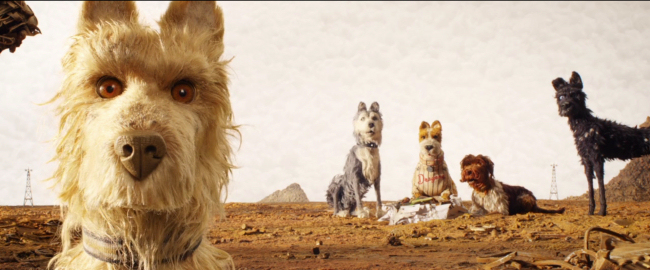
I'm more of a cat person, myself, but it seems like it would take a particularly mean person to be cruel to a dog. Certainly the seriously steadfast fellows in 2018's Isle of Dogs can't help but inspire affection with their angelic, unselfconscious loyalty. Director Wes Anderson's trademark self-consciously stylised aesthetic is perhaps part of the reason this never becomes cloying. Instead we have a beautiful stop motion diorama of some sweet, incredibly sincere souls.

You can't really invent a plausible motive for exiling everyone's beloved pets to a trash island, but plausibility isn't really the point of the film. So instead Anderson goes with a story about how a despotic mayor of the fictional town of Megasaki is fulfilling the agenda of his distant ancestors by concocting the myth of a "canine flu".

Many of the reviews that malign the film for cultural appropriation exhibit a weak understanding of Japanese culture and limited experience with Japanese film, generally fitting my impression that the ethnocentrism of such critics comes from the resentment they harbour for people who are better informed than they are (the movie's actual savviness about Japanese culture is well covered in this New Yorker article by Moeko Fujii). I was expecting references to Yasujiro Ozu, a filmmaker Anderson has acknowledged in the past as an influence, but mostly the film seems to be a love letter to Akira Kurosawa.

Much of the film follows a group of dogs, primarily the stray, Chief (Bryan Cranston), on the trash island as they endeavour to assist a boy named Atari (Koyu Rankin) in his efforts to find his beloved dog, Spots. The imagery is reminiscent of Kurosawa's first colour film, Dodes'ka-den, which is also mostly set on a trash heap, though Anderson's compositions are of course more broken into tidy coordinated segments. Though Dodes'ka-den certainly has a very carefully composed aesthetic.

Chief being a stray recalls Kurosawa's Stray Dog but the music associated with him early in the film is from Seven Samurai, probably the most recognisable Kurosawa element for the casual viewer. I was a little torn on it--it was sweet and I could see a thematic parallel between Chief and Kikuchiyo, but the theme from Seven Samurai is so indelibly associated with that movie for me it was a bit like hearing the "Imperial March". I was more pleasantly surprised by the guitar music from Kurosawa's 1948 film Drunken Angel which Anderson deploys for a quiet, romantic scene between Chief and a show dog named Nutmeg (Scarlett Johansson). In Drunken Angel, it's played on guitar by a man sitting by a cesspool caused by American bombing during World War II.
Kurosawa's films from the late 40s, most notably Stray Dog and Drunken Angel, frequently used locations that emphasised the post-war ruin of Tokyo. Isle of Dogs doesn't have that background but there is something of the spirit of Kurosawa's films in these characters intimately dedicated to honour in a world that encourages pragmatically selfish behaviour. Stray Dog presents a story in which the passion a young cop has for recovering the gun stolen from him is contrasted with the horrific cynicism of the film's villain, a young killer who describes killing a cat in one scene simply because its death is probably inevitable anyway.

That Isle of Dogs is centred on its most cynical character, Chief, is telling because he's really only cynical in contrast to the other dogs whose loyalty to their human masters is heartfelt and unwavering. From the first moment Chief warns Atari, "I bite," there's an apologetic quality to Chief's personality. He insists on his independence but still abides by votes taken by the group of dogs. Cranston is the perfect actor for the role; he can come off as completely self-confident while conveying an undertone of contradiction, a sense of a moral code that contradicts his surface assertions, something that made him as perfect for this as he was for Breaking Bad.

There are many great supporting performances, too, perfectly keyed to the film and characters; Bill Murray, Jeff Goldblum, Harvey Keitel. And of course it always looks great.

No comments:
Post a Comment